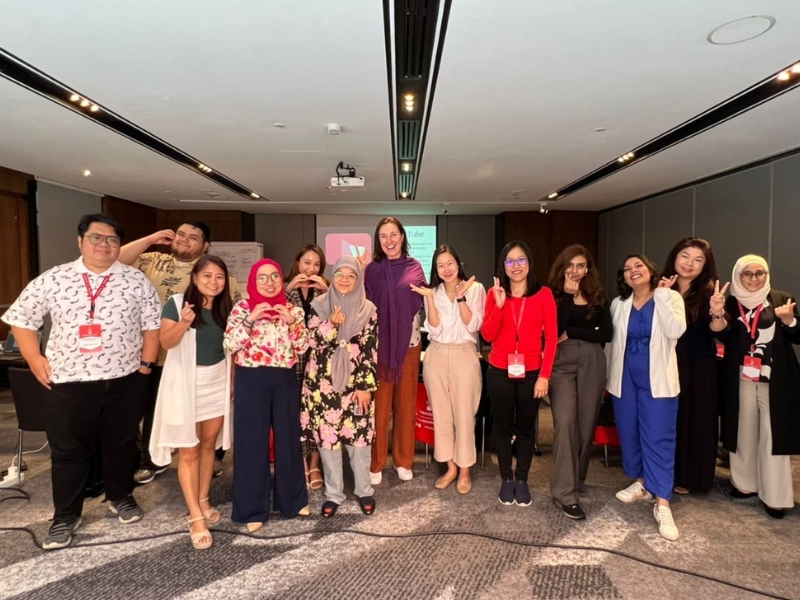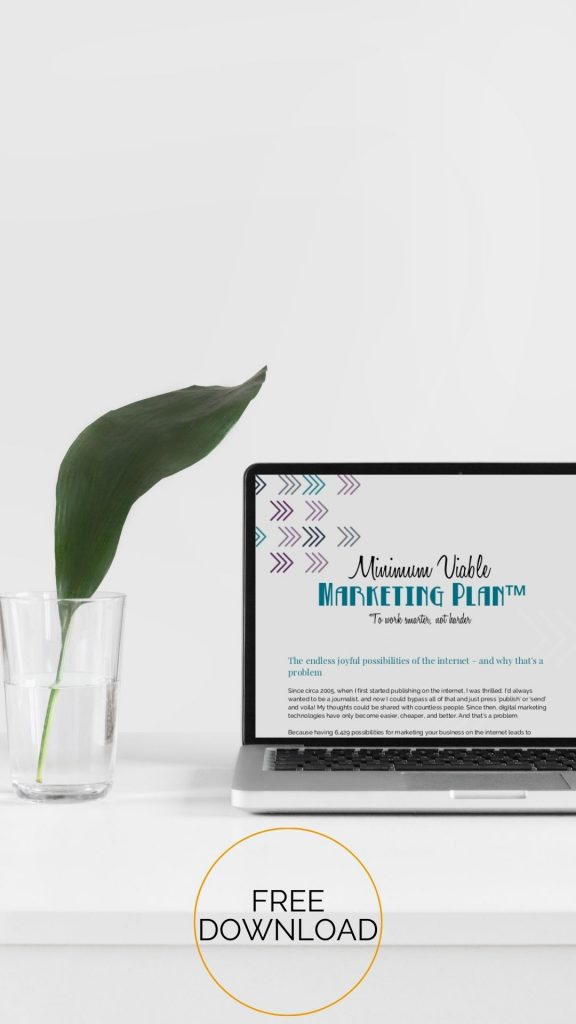In 2012, when my babies were aged two and three, I started running group courses around Australia, mainly to flee the chaos of working from home with my partner, who is also self-employed.
Friends would see our lives and gushingly say, “you’re living the dream!” But I was knee-deep in nappies, nap times, client phone calls, and other people’s marketing. It looked a lot different from the inside.
My very first course I held in a café in Newtown, on a stinking hot Sydney summer day. Seventeen owners turned up, and I had a blast. A couple of months later, I booked a flight to Melbourne and the rest, as they say, is history.
For about eight years, I ran courses across Australia, in venues large and small including hotels, gorgeous AirBNBs, restaurants, art galleries, and other creative spaces. I wish I’d kept records of all the different groups I’ve led over the years – I’m guessing it would number in the hundreds.
In 2015, I started running my flagship program, Hustle & Heart, and I’ve run countless short and long online courses, classes, keynotes, programs, webinars, conference presentations, and lunch-and-learns since, under my own brand, as well as on behalf of other businesses and training institutions.
In 2023, I taught internationally for the first time, running five different courses across two trips to Malaysia, on digital marketing and brand storytelling.
Here are the eleven key lessons that I’ve learnt, especially if you’re keen to start, or improve your skills in teaching groups.
1: Your authority has to be claimed
You and you alone must claim your authority to teach or train. And having experience of doing something in just your own business isn’t enough (“I’m proof!” is not proof. Rather, this is ‘evidence by anecdote’).
You need to have broad experience applying your expertise in a wide range of situations, over some years.
I’d been working in online communications for eight years when I began teaching. Before starting my business in 2008 as a digital marketing agency, I’d managed a large website on behalf of a multinational organisation, regularly interviewing, writing, and promoting articles (this was ancient history, before social media, before proper web analytics, when the technology looked very different).
I don’t believe you need qualifications to teach. I’ve met qualified trainers who are terrible and unqualified trainers who are awesome. You get to decide that you’re ready. Don’t let anyone (including me) stop you.
2: The first time will be the worst time
Nobody wants to hear this. The first time you deliver a new course, workshop or program will be the worst time – and the best time, if you stop stressing and criticising yourself and start living in the moment.
Time and again, I witness owners attempting to anticipate the unknowable and plan the unplannable, causing far more stress and work than is necessary.
I take plenty of notes while delivering my first course, including what’s good and what’s not, when chronology has gone a bit awry, and great questions from participants that I can work into draft two. The second time will be 73 per cent better. But you must do the first time to get to the second time.
3: Set expectations and welcome people in
If you love gathering groups together and haven’t yet read The Art of Gathering by Priya Parker, go get it now.
Recently, I attended a small event in Sydney in a private home. I got some automated emails, but none had the address. I was lucky to have the organiser’s mobile number (which wasn’t ideal and wasn’t in any email) and texted her to get the address.
When I arrived, the door was ajar so I let myself in. Nobody greeted me, nor said hi when I walked into a room with a long table full of people talking. (File this under ‘what not to do’).
Etiquette isn’t difficult – it’s mostly about being thoughtful, considerate, and anticipating other people’s needs.
4: Group dynamics are everything
Whether you’re face-to-face or online, group dynamics have a massive influence over the success or failure of a course or program.
I’ve taught the same course or program, at the same venue, with disastrous groups and excellent groups. The dynamics of groups cannot be underestimated.
Take your time in the beginning to settle in, set expectations or seek feedback on group agreements, share names and a little background info, and introduce yourself beyond your LinkedIn bio.
As the trainer or facilitator, you can influence the level of openness in the room by sharing personal or quirky or funny information about yourself, permitting others to do similarly.
5: Give people a quick win
I once called a course participant, asking for her feedback, who told me, “you took too long to give me the first actionable tip. I don’t care about the history of social media.” Fair call.
Too often, we cling to chronology without thinking about our audience – who are there because they want a transformation.
Unless you’re teaching history, forget about giving too much background information.
Structure all your training and facilitation to give a quick win upfront – something highly valuable that causes people to sit up, take notice, and immediately apply what they’ve learnt for significant gains.
This has multiple benefits: it earns people’s trust and attention, it will be remembered far more if it’s at the beginning or the end, than lost in the middle, and it gives you satisfaction, and hence, motivation to do a stellar job.
6: Teaching is far more than knowledge and information
In the age of Google and YouTube, you better believe that teaching is about far more than just information. We buy group programs and online courses because we want a guide to curate only the most essential information and help us to apply it to our unique situations.
I like to factor in a 50/50 ratio of learning and applying, which means if I teach a concept for 20 minutes, then we have 20 minutes to apply this in an exercise, reflect, discuss, and seek feedback. All of my courses and programs have an assignment of sorts that participants complete throughout – whether this is a marketing plan, profit plan, sales page, or email funnel.
Nobody wants to leave a course with a notebook of good intentions that quickly gathers dust, leaving you feeling guilty and resentful.
7: Tap into the wisdom of the group
While teaching/training and facilitation are often discussed together, there is a massive difference between these.
Training is the old-school model from school where the teacher talks from the front of the room. Facilitation is when the facilitator provides resources, questions, exercises, and opportunities to provoke the group to discuss, share, apply and learn together, harnessing the collective wisdom of the group.
A skilled person can move seamlessly between training and facilitation, as the situation requires.
8: Make it relevant to make it powerful
Knowledge is theoretical. When we apply it, we make it practical. Examples from the real world go a long way to illustrate your teachings and how they can be applied.
But the best skill you can cultivate as a teacher, trainer or facilitator, is thinking quickly and speaking confidently, to apply what you’ve just taught to a participant’s unique circumstances.
After 11 years and hundreds of groups, this is one of my superpowers. When we make it relevant to people, we make it powerfully valuable.
9: Feedback is invaluable – treat it as such
Two years of receiving weekly feedback, when I worked as a tour leader in south-east Asia, has given me a thicker skin with feedback. Even feedback that is seemingly irrelevant can hold a kernel of value for you – perhaps if only to show how your marketing needs to change, to better repel the wrong people.
Don’t be so precious that you put yourself above feedback. And if someone is willing to give it, be curious, courteous, and grateful, even when you don’t like what you hear.
10: Don’t be boring
Boring should be a crime. Life is short and other people’s precious time and attention is the most precious thing we have. Don’t squander it by being dull.
I learnt how to be more entertaining by analysing others on stage – noticing why some people appeared dull, and others were entertaining.
Much of this has to do with energetic presence. You can be more entertaining, fascinating and interesting to others by being more interested in others, more present, and thus, more spontaneous. When we’re not caught up in our heads, we’re naturally more charismatic. Plus, your jokes get funnier the more you practise them.
11: Make it simple, not simplistic
“If you can’t explain it simply, you don’t understand it well enough” said Albert Einstein.
Many people misunderstand this and believe the opposite to be true: that something must appear complex and difficult if it’s to be valued. Ha! It takes a lot of skill to make something complex appear easy and simple.
However, simple is not simplistic. We undermine other’s intelligence, while also eroding our credibility and authority when we overlook subtleties, nuances, and exceptions to the rule, in favour of black-and-white statements.
My aim in teaching and training is to always make the complex appear simple and easy. When we can equip our participants with knowledge and empower them to apply it immediately, then gains become exponential, as the gap between knowing and doing disappears.
Would you like to elevate your expertise into a premium flagship group program? This is exactly what we do inside of the Leverage Mastermind.





